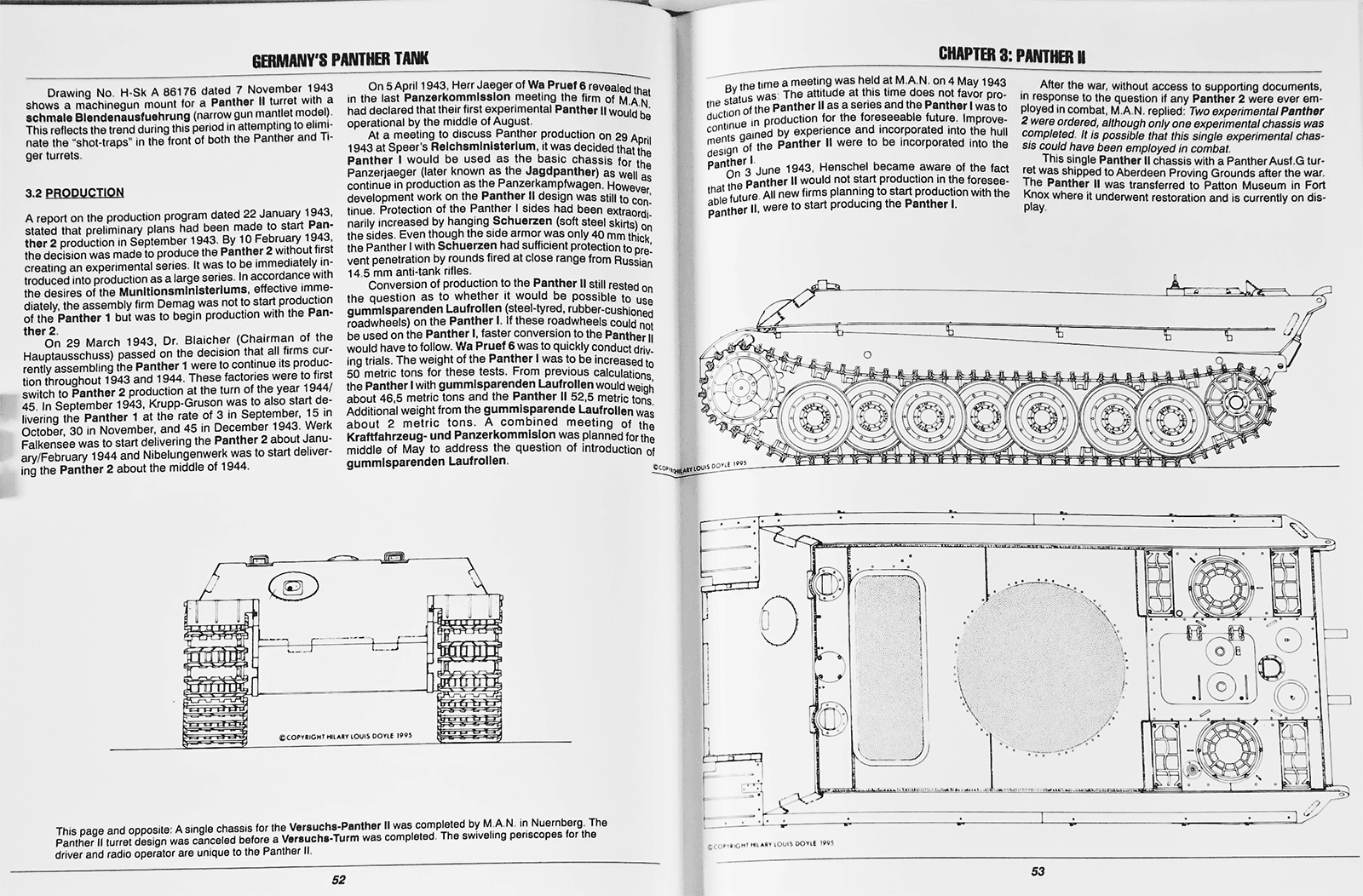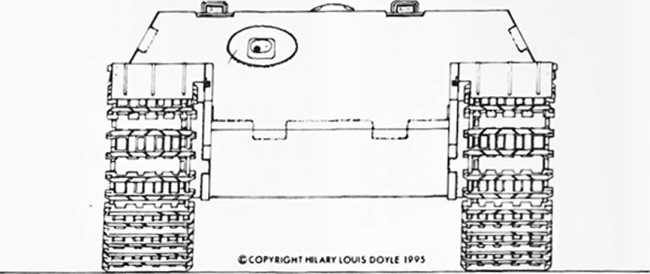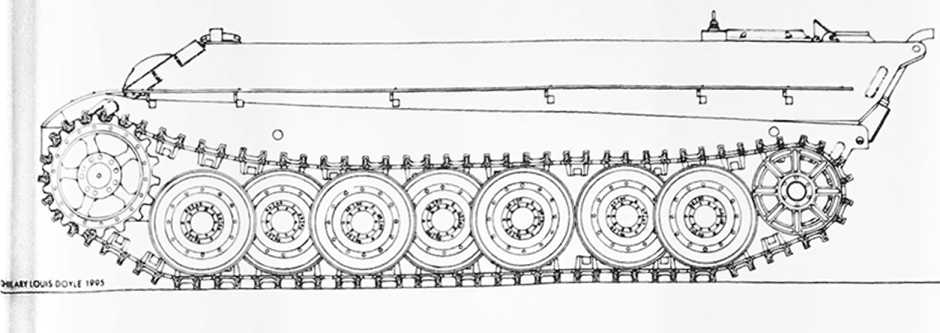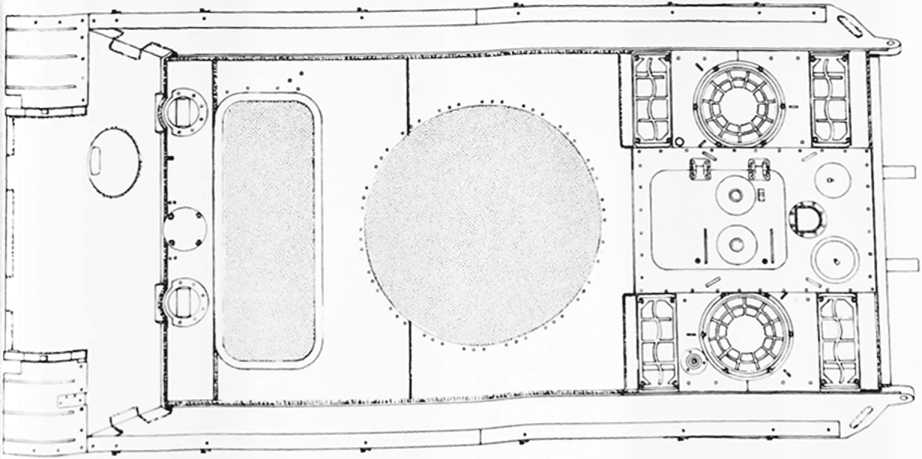028

GERMANY'S PANTHER TANK
Drawmg No H-Sk A 86176 dated 7 November 1943 shows a machmegun mount for a Panthor II turret wilh a schmaleBlendenausfuehrung (narrowgun mantlet model) This reflects the trend during this period in attemptmg to elimi-nate the “shot-traps" in the front of both the Panther and Ti-ger turrets
A report on the production program dated 22 January 1943. stated that prelimmary plans had been madę to start Panther 2 production in September 1943. By 10 February 1943. the decision was madę to produce the Panther 2 without first creating an experimental senes It was to be immediately in-troduced mto production as a large senes. In accordance with the desires of the Munltionsmlnlsterlums. effective imme-diately. the assembly firm Demag was not to start production of the Panther 1 but was to begin production with the Panther 2
On 29 March 1943. Dr. Blaicher (Chairman of the Hauptausschuss) passed on the decision that all firms cur-rently assemblmg the Panther 1 were to continue its production throughout 1943 and 1944. These factories were to first switch to Panther 2 production at the turn of the year 1944/ 45. In September 1943. Krupp-Gruson was to also start de-livermg the Panther 1 at the ratę of 3 in September. 15 in October. 30 in November. and 45 in December 1943. Werk Falkensee was to start delivering the Panther 2 about Janu-ary/February 1944 and Nibelungenwerk was to start deliver-ing the Panther 2 about the middle of 1944.
On 5 April 1943. Herr Jaeger of Wa Pruef 6 reveaied that in the last Panzerkommlsslon meeting the firm of M A N. had declared that their first experimental Panther II would be operational by the middle of August.
At a meeting to discuss Panther production on 29 April 1943 at Speer s Relchsmlnlsterlum. it was decided that the Panther I would be used as the basie chassis for the Panzerjaeger (later known as the Jagdpanther) as well as continue m production as the Panzerkampfwagen. However. development work on the Panther II design was still to continue. Protection of the Panther I sides had been extraordi-narily mereased by hanging Schuerzen (soft Steel skirts) on the sides. Even though the side armor was only 40 mm thick. the Panther I with Schuerzen had sufficient protection to pre-vent penetration by rounds fired at close rangę from Russian 14 5 mm anti-tank rifles.
Conversion of production to the Panther II still rested on the question as to whether it would be possible to use gummlsparenden Laufrollen (steel-tyred. rubber-cushioned roadwheels) on the Panther I. If these roadwheels could not be used on the Panther I. faster conversion to the Panther II would have to follow. Wa Pruef 6 was to quickly conduct driv* ing trials. The weight of the Panther I was to be inereased to 50 mętne tons for these tests. From previous calculations. the Panther I with gummlsparenden Laufrollen would weigh about 46.5 metric tons and the Panther II 52,5 metric tons. Additional weight from the gummlsparende Laufrollen was about 2 metric tons. A combined meeting of the Kraftfahrzeug- und Panzerkommlslon was planned for the middle of May to address the question of introduction of gummlsparenden Laufrollen. Cl

This page and opposile A single chassis for the Versuch8-Panther II was completed by M A N in Nuernberg. The Panther II turret design was canceled before a Versuche-Turm was completed The swiveling penscopes for the dnver and radio operator are umque to the Panther II

CHAPTER 3: PANTHER H
By the time a meeting was held at M.A.N. on 4 May 1943 the status was The attitude at this time does not favor production ot the Panther II as a senes and the Panther I was to continue m production for the foreseeable futurę. tmprove-ments gamed by experience and incorporated mto the hull design of the Panther II were to be incorporated into the Panther I
On 3 June 1943, Henschel became aware of the fact that the Panther II would not start production in the foresee-able futurę Ali new firms planning to start production with the Panther II. were to start producing the Panther I.
After the war. without access to supportmg documents, in response to the question if any Panther 2 were ever em-ployed m combat, M A N. replied: Two expenmentalPanther 2 were ordered, although onlyone experimental chassis was completed It is possible that this single experimental chassis could have been employed m combat
This single Panther II chassis with a Panther Ausf.G turret was shipped to Aberdeen Provmg Grounds after the war. The Panther II was transferred to Patton Museum in Fort Knox where it underwent restoration and is currently on display


C« *•**•»lOwiOOYU
53
Wyszukiwarka
Podobne podstrony:
GERMAN Y S PANTHEH TANK was almost completed. A model of the motor was complete and was to be sent t
GERMANY S PANTHER TANK The spent MG cartndge tubę pulled out when the n s depressed When the gun was
GERMANYS PANTHER TANK Dn 21 February 1943 a Jak* steer.ng gears) (CHY) :,on Au of
GERMANY S PANTHER TANK I Befehls-Panther Ausf D. Tactical Nr 155. possessed the last changes madę to
GERMANY S PANTHER TANK Tne omy cnass-s compieted for tne Versuchs-Panther II was captured Dy tne Ame
GERMANYS PANTHER TANK Panther Ausf A (Fgst Nr 152151 produced by Daimler-Benz on 0r about 16 Decembe
GERMANV S PANTHER TANK 7.5 cm Kw.K.42 L 70 Extornal Travel Lock Commandor’8 Cudoi* 021St
GERMANY S PANTHER TANK 4 3.11 CREW COMPARTMENT HEATER AND ENGINE Durmg cold weather. the Kampfraumhe
GERMANYS PANTHER TANK Panzarkampfwagen Panther (7.5 cm Kw.K.42 L.70) (Sd.Ktz.171) An Auafuehrung A w
GERMANYS PANTHER TANK 4 3 13 WATERTLGHT SEALS BEHINB THE GUN MANTLET On 16 March 1944 MNH was mforme
GERMANYS PANTHER TANK Track dOjustment left 48306 48306 Track ad
GERMANY S PANTHER TANK any Panther completed m November The Panthers already prepared for msiallatio
GERMANYS PANTHER TANK As an expedient to mcrease protection against strafing aircraft and splinters
GERMAN Y S PANTHER TANK Rhemmetall designed a Panther turret with a narrow gun mantlet. penscopic gu
GERMANYS PANTHER TANK Above and opposite above A Versuchs-Schmalturm (experimental narrow turret) mo
GERMANYS PANTHER TANK succeed in producmg a single 1 32 m rangefmder before the end ot ihe war Devel
GERMANY S PANTHER TANK Table 9.1.2:
GERMANY S PANTHER TANK In addition. lucky hits on the lower half of the original gun mantlet sometim
GERMANYS PANTHER TANK STATUS OF OPERATIONAL PANTHERS Oparallon ZHadada from 5 to 17 Juty 1043 ICO 10
więcej podobnych podstron